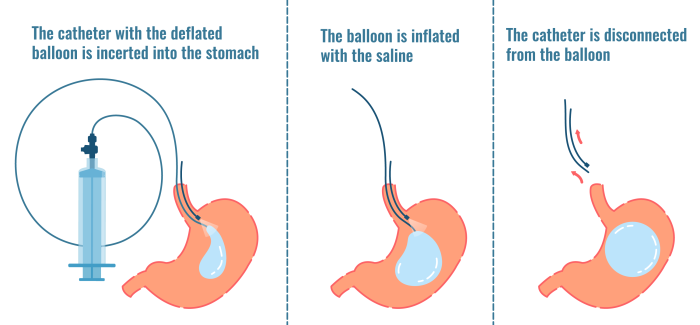An intragastric balloon is a non-surgical weight loss device that is placed in the stomach to help individuals achieve significant weight loss by promoting a feeling of fullness. It is designed to aid those who are struggling with obesity when traditional weight loss methods have failed.
How the Intragastric Balloon is Placed
The placement of an intragastric balloon is a minimally invasive procedure performed under sedation. The deflated balloon is inserted through the mouth and into the stomach, where it is then inflated with saline to occupy space and reduce stomach capacity.

Mechanism of Action: How the Balloon Controls Appetite
The balloon creates a sensation of fullness by taking up space in the stomach, which signals the brain to reduce appetite. This leads to decreased food intake and assists in weight management.
The Role of Stomach Volume in Appetite Regulation
The intragastric balloon reduces the stomach's effective volume, thereby limiting the amount of food that can be consumed at one time, which aids in controlling hunger and appetite.
The Impact of the Intragastric Balloon on Food Intake
By occupying space in the stomach, the intragastric balloon significantly reduces the volume of food intake, helping patients eat smaller portions and make healthier food choices.
Psychological Effects of the Intragastric Balloon on Eating Habits
The intragastric balloon can positively affect eating behaviors by encouraging patients to develop healthier relationships with food, as it emphasizes portion control and mindfulness during meals.

Benefits of Using an Intragastric Balloon for Weight Loss
The intragastric balloon offers several benefits, including non-surgical weight loss, improved health conditions related to obesity, and increased motivation for lifestyle changes.
Potential Side Effects and Risks of the Intragastric Balloon
While generally safe, the intragastric balloon can have side effects such as nausea, vomiting, abdominal pain, and, in rare cases, more serious complications like balloon deflation or obstruction.
Who is a Suitable Candidate for the Intragastric Balloon?
Suitable candidates for the intragastric balloon include individuals with a BMI of 30 or higher who have not achieved sustainable weight loss through diet and exercise alone, as well as those who may not be eligible for surgical options.
The Process of Balloon Removal: What to Expect
The removal of the intragastric balloon is a simple outpatient procedure performed endoscopically. It typically involves deflating the balloon and removing it through the mouth, with minimal recovery time required afterward.
Combining the Intragastric Balloon with Diet and Exercise
Integrating the intragastric balloon with a structured diet and exercise regimen significantly enhances weight loss outcomes. While the balloon helps control appetite and food intake, adhering to a nutritious diet and maintaining physical activity are crucial for achieving sustainable weight loss.
Long-Term Effects of the Intragastric Balloon on Weight Loss
Research indicates that patients with an intragastric balloon can achieve substantial weight loss, which can be maintained long-term with lifestyle changes. Regular monitoring and commitment to healthy habits contribute to ongoing success in managing weight after balloon removal.

Comparing the Intragastric Balloon with Other Bariatric Procedures
The intragastric balloon is less invasive than traditional bariatric surgeries, offering a temporary solution for weight loss. Unlike procedures like gastric bypass, which permanently alter the digestive system, the balloon provides a reversible option with fewer complications and quicker recovery times.
Success Stories: Real-Life Experiences with Intragastric Balloons
Numerous patients have shared positive experiences with the intragastric balloon, highlighting significant weight loss, improved self-esteem, and enhanced quality of life. These success stories serve as motivation for others considering this weight loss method.
Nutritional Considerations While Using an Intragastric Balloon
While using the intragastric balloon, focusing on a balanced diet rich in nutrients is essential. Patients are encouraged to prioritize high-protein foods, fruits, vegetables, and whole grains while avoiding sugary and high-fat foods to maximize weight loss benefits.
How to Prepare for Intragastric Balloon Insertion
Preparing for intragastric balloon insertion involves a comprehensive assessment by a healthcare provider, which may include medical evaluations and dietary consultations. Patients should follow pre-operative guidelines, such as adjusting their diet and avoiding certain medications.
Monitoring Progress: Follow-Up After Intragastric Balloon Placement
Regular follow-up appointments after balloon placement are vital for monitoring weight loss progress, addressing any side effects, and making necessary dietary adjustments. Ongoing support ensures patients stay on track with their weight loss journey.
Addressing Common Misconceptions About Intragastric Balloons
There are many misconceptions about the intragastric balloon, such as its effectiveness or safety. Educating patients about its temporary nature, its role in appetite control, and the necessity of lifestyle changes can help clarify these misunderstandings.
The Role of Support Groups in Managing Weight Loss with a Balloon
Support groups play a crucial role in the weight loss journey with an intragastric balloon. Connecting with others facing similar challenges provides emotional support, motivation, and practical advice for maintaining healthy habits.
Future Innovations in Appetite Control Technologies
The field of appetite control is evolving, with future innovations promising even more effective solutions for weight management. Emerging technologies, such as advanced gastric devices and smart monitoring systems, aim to enhance patient outcomes and improve long-term weight loss success.
The Effect of the Intragastric Balloon on Gut Microbiome
Delve into the influence of the intragastric balloon on the gut microbiome. Emerging research suggests that this weight loss intervention may alter gut bacteria composition, potentially enhancing digestive health and contributing to improved metabolic functions, highlighting the broader implications of this treatment beyond weight loss.
Best Intragastric Balloon Treatment in India
The Best Intragastric Balloon Treatment in India is performed by expert surgeons who utilize advanced techniques to ensure optimal outcomes for patients, offering a personalized treatment plan tailored to individual health needs.
Best Intragastric Balloon Hospitals in India
The Best Intragastric Balloon Hospitals in India are equipped with cutting-edge technology and facilities, providing top-notch care, including pre-surgery consultations, surgical expertise, and post-operative recovery support to ensure a smooth patient journey.
Intragastric Balloon Cost in India
When considering the Intragastric Balloon Cost in India, patients benefit from affordable and transparent pricing at leading hospitals, which offer cost-effective treatment options without compromising the quality of care.
Best Intragastric Balloon Doctors in India
The Best Intragastric Balloon Doctors in India are highly experienced in performing the surgery, utilizing a patient-centric approach that ensures personalized care, precise surgical techniques, and dedicated follow-up care to enhance recovery.
FAQ for Intragastric Balloon Works to Control Appetite
How long can an intragastric balloon stay in place?
An intragastric balloon is typically designed to remain in the stomach for about six months. After this period, it is usually removed to prevent complications and maintain optimal health.
What types of foods should I avoid while using the intragastric balloon?
While using the intragastric balloon, it’s best to avoid high-sugar and high-fat foods, as well as carbonated beverages, as they can lead to discomfort and hinder weight loss efforts. Focus on a balanced diet rich in lean proteins, fruits, vegetables, and whole grains.
How effective is the intragastric balloon for long-term weight loss?
The intragastric balloon can lead to significant weight loss during its placement period, with many patients achieving a reduction of 20-30% of their excess weight. Long-term success depends on the adoption of healthy lifestyle changes and ongoing support after the balloon is removed.
Will I feel discomfort after the intragastric balloon is placed?
Some patients may experience mild discomfort, nausea, or abdominal pain following balloon placement, especially in the first few days. These symptoms typically subside as the body adjusts to the presence of the balloon.
Can the intragastric balloon be used for patients with specific medical conditions?
While the intragastric balloon is generally safe for many patients, those with certain medical conditions, such as severe gastrointestinal disorders or allergies to the materials used, may not be suitable candidates. A thorough evaluation by a healthcare professional is essential to determine eligibility.